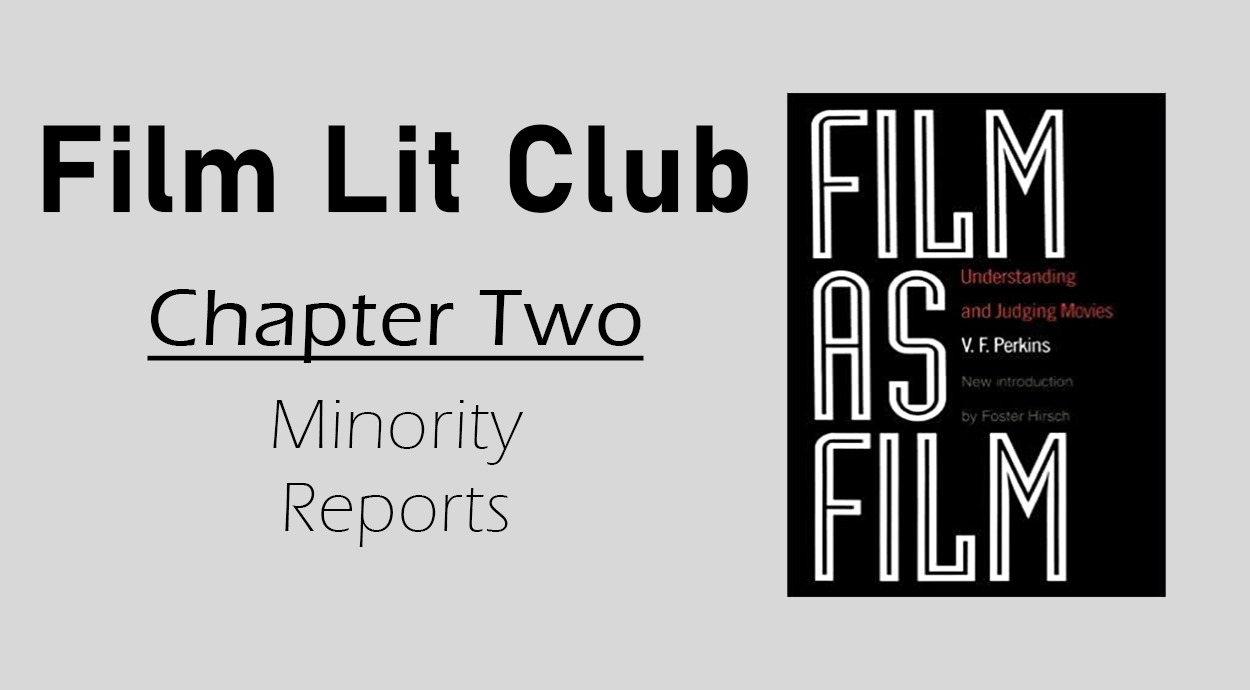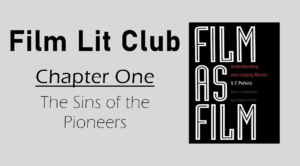Welcome back to the Film Lit Club, a series discussing books on (if you couldn’t guess) film. At the last meeting, if you’re not caught up, we looked into Film as Film by V.F. Perkins: a wonderful collection of essays that bring the form and art of cinema into a new line of questioning. The first chapter questioned the “rules,” the prestige standard film pioneers conformed to when bringing movies into the limelight. I gave my thoughts on the definition of art and the limit this boundary places on film, the problem with sticking to such an ancient description when movies could have exceeded those ideas.
Perkins brings these notions that are academic in nature and puts them plainly for the unscholarly to understand. His “simple” jargon conveys intellectual ideas that will capture any casual reader of film theory’s interest while making you feel much more enlightened by his laymen’s breakdown of cinema studies and critical analysis.
In this second chapter, after accepting the task filmmaking pioneers took to cement the film as an art form, we are thrust into another question of movie roots: its purpose—the primary facet of the motion picture camera’s design. Perkins turns to critical writers who came before him for support while simultaneously criticizing these colleagues’ shortcomings in their preceding conjecture.
If you don’t have a copy (and if you’re a film lover, you really should), I’ll be using scanned pages of selected passages. Here’s a link to a digital library version that you can borrow freely and this downloadable file if you prefer. I invite you to read along with me and form your thoughts and opinions on what Perkins is saying; maybe you agree with my interpretation of the text (or disagree). Share your thoughts in the comments, and start a discussion!
Chapter Two: Minority Reports
“Minority Reports” is a relatively misleading title, especially if you were interested in reading a critical discussion of how gender and race play into film theory. Sadly that’s not the case here (I’ll look for readings like that in the future). Instead, we have an exploration of film critic André Bazin’s informal “theory of film” found in the first volume of his posthumously-published collection of articles, Qu’est-ce que le Cinema? Serving as our aforementioned “minority,” Bazin was a French film critic and theorist with no qualms about opposing the status quo, writing articles in university that were implicit criticisms of the pro-Nazi governmental regime. His position as a contrarian leaked into his role in film studies, arguing against the accepted cinema theories of the 1920s and 30s. That is the source of contention of Perkins’ writing.
Bazin was a profound believer that the framework of cinema lies in the motion camera’s function as a capture device for the natural world. In other words, Bazin argued that film’s aesthetic relies on recording the physical world we inhabit without interpretation from an artist (or, in film terms, the director). We almost harken back to the previous chapter’s discussion, making the read-through of both chapters one after the other practically necessary. Many are fighting for the evaluation of film as an art form, but Bazin makes the distinction that calling cinema an ‘art’ does the objective of the medium a disservice.

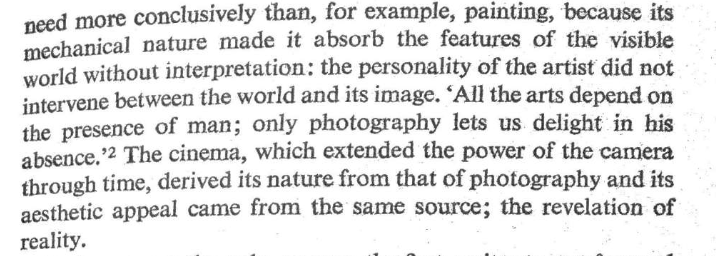
I love that line right there in the middle: “All the arts depend on the presence of man; only photography [with cinema considered an extension of this] lets us delight in his absence.”
We’re introduced to a contemporary of Perkins’, Siegfried Kracauer, who held a similar position to Bazin on the objectivity cinema must naturally contain. Kracauer is labeled as “less coheren[t] and [having] a more obscure, at times impenetrable, line of reasoning,” a manner of criticism that only good ol’ V.F. would put so amiably. But going back to that quoted sentence, it’s a sentiment that is crucial to what both critics believe for the inherent purpose of cinema.
Break it down like this: A painting requires a painter (duh!); this painter abides by personal philosophy, an outlook on the world shaped by their life. If you ask them to paint a scene of a historical event, the product of this artistic venture will contain some remnants of the painter’s personal views and prejudices. No matter how realistic it looks, even bordering on photographic, those biases from the artist become a distortion of the reality it is meant to depict. The filmmaker cannot create a film with a singular, intrinsic purpose, leaving little up to interpretation.
This depiction of reality was realized in Italian neorealism films, such as Rosellini’s Paisa or de Sica’s Bicycle Thieves. The filmmaking style molded Bazin’s views on cinematic realism, clearly by his critical praise for those classical movies. Calling them the exemplary model for what he was preaching, Bazin reveled in the proof of keeping the depiction of the natural world a priority over crafting dramatic sequences that distract from his aspiring “pure” cinema aesthetic.
Considering all that (and we’re only on page 4 of this one!), the “purpose” of the camera hypothesis isn’t too far-fetched. The camera is a device capable of freezing time, like its preliminary photography form attached to this same thesis. Capturing a moment that, in the grand scheme of things, can only be created once as it occurs, the assumed priority of the camera would be an unbiased record of natural events, like in a documentary.
That’s how early cinema took it to be used, creating actualities that project impartial regular events that not everyone is aware of. When filmmakers began crafting stories, inflecting the motion camera with elements of drama, and transforming the “revelation of reality” into art in the vein of stage theater and the written novel, the device’s original designation was, for the sake of Bazin and Kracauer’s argument, spoiled. Dramatic sounding? I imagine it’s how seriously those two film appraisers would take it.
Editing, particularly the Russian school of montage theory, is cited as the diluting factor of the encapsulation of realism in cinema. For the French, ‘montage’ refers to the general act of editing. But the Russian theory utilized montage to create symbolism between objects and the viewing audience, a direct antithesis to what Perkins has informed us of.
You’ve seen montage wielded in Sergei Eisenstein’s pictures, like Battleship Potemkin and Strike. They invoke a response by “isolat[ing] objects and actions from the background which made them significant…a significance of the director’s own creation.”

Knowing how the art of editing is such a valued and intrinsic piece of the filmmaking process, this is such a strange view to hold. Pioneering editors like Eisenstein or Lev Kuleshov were firm believers that editing is the essence of the film. These conveyances of emotion and linkage between cutting from different shots are necessary for film to be film. To reconcile this fact, Bazin and Kracauer argue that the problem isn’t the montage form but the lack of ambiguity tied into it. Quite accurately, the issue is in the singular meaning filmmakers place into these shots, rather than allowing for multiple meanings. I mentioned this before with the analogy of painters painting their views into their pieces. Filmmakers do this too, which depreciates the essence of reality for these films.
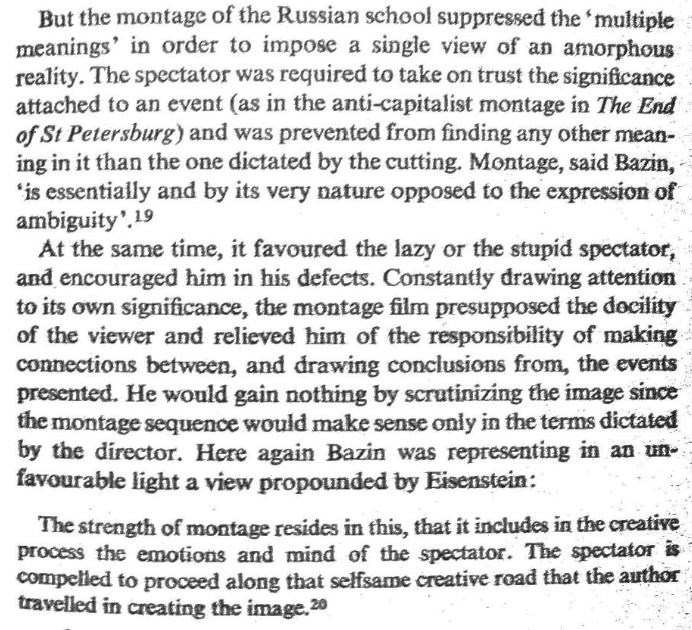
It’s a very compelling thought; you have to admit. It’s got that #FilmTwitter sensibility of calling audiences dumb and lazy because they don’t like movies that prompt questioning or hard-thinking. When the film does all the work of telling you what to believe, I agree that you create an unmotivated audience. Not every movie with these montage edits is so singular, I think; there’s always room for investigation through media literacy on what a director’s message might extend to. But that’s such a stretch, and after you’ve already molded the spectator into having preconceived reactions to what is projected, you probably won’t prompt much of a query from them.
Following this, we’re treated to Perkins dissecting the failings of this emotional editing with particular sequences from Nanook of the North (1920), Buster Keaton’s The Navigator (1924), and the French serial film Tih Minh (1918) as his models. He illustrates the lack of cutting in each of these segments as it organically intensifies these moments within the perceived film space. For Nanook, it’s when the eponymous fisherman is struggling to reel in a seal, fighting and pulling. The tension isn’t created with quick cuts and intense close-ups but with the audience’s knowledge of this back-and-forth. Without watching this play out naturally, Perkins and Bazin argue, you’d lose that source of drama.
As polite as Perkins can, Keaton is roasted for his “uncreative” camera work. Perkins writes, “It reported the incident as impassively as Keaton portrayed it, changing position not for effect but simply in order to maintain the spectator’s view of some highly mobile proceedings.” Highly observant, but I think Keaton’s cinematography sensibilities go a little beyond that at points in his filmmaking. But Perkins’ perceived criticism is meant to praise, as Bazin’s theory of objective cinema places the comedian’s work in high regard for this type of recording.
Perkins’ assessment of Tih Minh is equally astute, fully aware of the functionality this type of editing has in creating drama with no cuts.
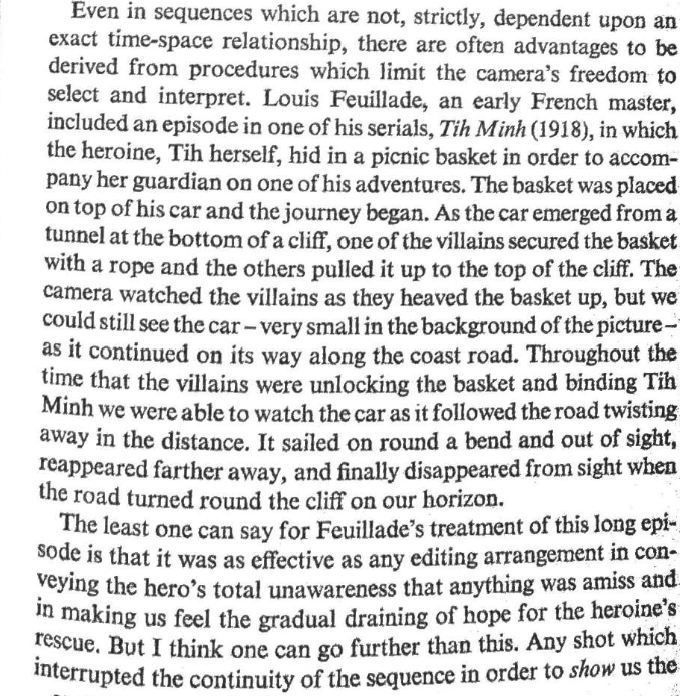
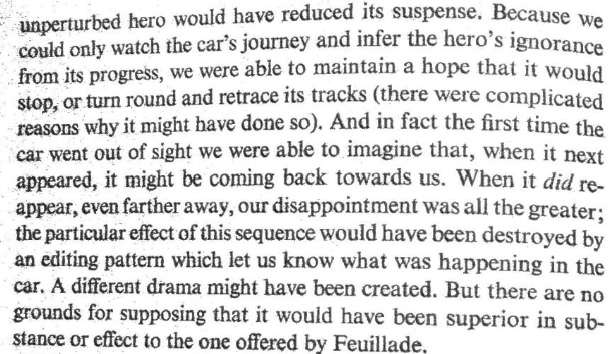
The accepted cinema theory is pointed out, focusing on the film image and what it can say about our natural world. But the flaws in this orthodoxy started to reveal themselves with the invention of sound capture and the ‘talkies’ taking shape in world cinema. Theorists like Rudolph Arnheim, prominently mentioned in the last chapter, have been unable to reconcile the introduction of a soundtrack to motion pictures under the traditional theory. If a film is about the visual, the image of the world, how does sound and audible dialog fit into that view?; this was a question that Bazin’s theory could be responsive to. Arnheim stated, in the orthodox view:

Bazin’s hypothesis negates this need for a relationship between body and voice beyond biology because that relationship is already inherent to the natural world. Our reality is captured that much closer with sound, so Bazin’s counter to the accepted theory is given more weight behind it. This exposes such a problem with the standard view that you would think Bazin, Kracauer, and Perkins be taken and offered praise for this encompassing theory; what was initially contrarian could become conventional.
But, in the final few paragraphs, Perkins turns on the revered French critic, giving his cinematic proposal a wordy thrashing. He calls the theory half-baked; nothing practical about the film world and its realities. It’s attached to his cinematic tastes and preferences, alluding to Bazin’s favoring of Italian neorealism and the works of Renoir, Welles, and Wyler. Perkins refers to the views as “just as constricting as the orthodoxy,” becoming almost a dogma.
That’s the big difference between the two, despite their agreement on the subject. Perkins is willing to believe that cinema is all these things. Cinema is capturing reality like Bazin and Kracauer have made a case for, but it is also a depiction, an idealized view for others. It contains personal beliefs, political messages, and singular meanings that the audience is meant to follow. It can be ambiguous, allowing the spectator to come to their own conclusions.
 Bazin’s theory is flawed because it was not meant as a well-crafted theory in the first place. From a series of essays written for publication, it is only a portion of his view on cinema. But, as Perkins says, it is telling. We can gather from the reading that there was a faint line for Bazin as a critic; when should he have forgone partiality to particular styles and where he should’ve taken it to theoretical sense and overlooked these inclinations.
Bazin’s theory is flawed because it was not meant as a well-crafted theory in the first place. From a series of essays written for publication, it is only a portion of his view on cinema. But, as Perkins says, it is telling. We can gather from the reading that there was a faint line for Bazin as a critic; when should he have forgone partiality to particular styles and where he should’ve taken it to theoretical sense and overlooked these inclinations.
Perkins touches on the idea of pure cinema, a term I’m not personally fond of. He clarifies that all viewers have their ideas of what cinema is or can be and that they all probably have some foundation of validity. In my book, his last few lines put such an argument to rest: “In defining the film by reference to one of its features, it resembles the orthodoxy…Both theories discriminate in favor of certain kinds of cinematic effect…these positions presupposes a philosophy… terrain which the theorist should leave open for the filmmaker to explore and present.”
If you genuinely love it and appreciate it, cinema is all these things. It is a tool to be used and formed however you see fit. Does Bazin miss that point on purpose? I don’t think so; he was an intelligent guy and film lover. Based on Perkins’ thrilling commentary, the argument just got ahead of him on its own. It’s the fault of needing a purpose behind something; there must’ve been intent behind the function of the film camera, in Bazin’s mind. And there might’ve been.
But cinema moved beyond that purpose rather quickly, taking on the job of whichever innovative filmmakers took it into their hands. And that’s all we need to understand.
Conclusion
Minority Report refers to the theoretical minority, the ideas about film analysis and practice that is/were considered non-traditional. This particular minority view made a big splash in the scholarly community for its proposal of some intrinsic solitary purpose behind motion pictures and what that might be.
Though he has his own beliefs on the argument, Perkins is clear-headed enough to know that the movies take on different meanings, both for their creators and their viewers. Per my last review, this was an eye-catching and comprehensive dissection of different views on film theory that go by like that. Quick reads, but you come out of it with some new knowledge and an urge to seek more answers if you’re curious enough.
Maybe you’re not satisfied with Perkins’ breakdown of the objective cinema theory from Bazin. After reading this chapter, I think that reading the cited footnotes from Bazin’s book, What is Cinema? Vol. 1 would be an excellent place to keep that discussion flowing in your thoughts.
Let me know in the comments what you think of my analysis of the second chapter in Film as Film. Any thoughts on Perkins’ dissention from Bazin? Do you think the film has a pure form that has been distorted? Till the next book club meeting… Cheers!
